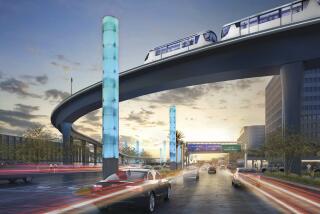Hughes to Share Grant for Transit System Project : Conversion: Firm’s Fullerton plant will use Pentagon funds to make radar sensors for BART.
- Share via
FULLERTON — Hughes Aircraft Co. said Wednesday it will share a $19.5-million grant to use military radar technology to double the traffic capacity of the Bay Area Rapid Transit system in the San Francisco area.
The award is part of the Pentagon’s technology reinvestment project, which earmarks federal funds for projects that promise to convert military technology to commercial uses.
The aerospace company’s Fullerton plant will work with BART and train-maker Morrison Knudsen in Boise, Idaho, to develop radar sensors for trains that will tell traffic engineers exactly where each train is located during use, said Robert Singer, a Hughes program manager. He said the program, as envisioned, could employ 400 to 500 high-tech workers for at least a decade.
This precise data on the system will allow engineers to shorten the spacing between each train moving at a full speed of 70 m.p.h. from 2.5 minutes now to about 90 seconds, enabling traffic engineers to place more trains on a given stretch of tracks and doubling traffic capacity without compromising safety.
The Defense Department on Wednesday announced 50 grants worth $190 million, the fourth round of technology reinvestment awards to teams of companies and organizations that applied for the grants during the past year.
Other grant winners included Rockwell International Corp. in Seal Beach, which proposed a $7.2-million project to significantly reduce the cost of radio frequency components used in analog and digital communications, and a team made up of Loral Western Development Labs, UC Irvine and Georgetown University Medical Center, which proposed a $2.8-million project to develop an all-digital radiology Picture Archiving and Communications System for hospitals.
Each member of the Hughes-Morrison Knudsen team will contribute matching funds to the project, bringing its value to $39 million.
BART, which will add 34 miles of track to its 71 1/2-mile regional rail system in 1995, needs the extra capacity as it lays tracks between the suburbs of Dublin and Pleasanton, said Marv Swensen, manager of train-related programs at Hughes in Fullerton.
Dorothy Dugger, a BART spokeswoman, said that doubling the system’s capacity across the San Francisco Bay by conventional means, such as building new tracks, would cost an estimated $4 billion. She said the new technology could allow BART to run 30 trains per hour instead of 16, enabling the transit system to carry 60,000 more passengers a day during rush hours.
“BART is the first in a number of upcoming urban transit upgrades,” Singer said. “We think the technology could be used to upgrade systems in New York, Atlanta, Philadelphia and Washington, D.C.”
Hughes’ Fullerton unit developed what it calls the Enhanced Position Location Reporting System, a mobile data communications network that could secretly transfer orders, to help troops find their location without relying on landmarks and to pinpoint friendly troops.
Hughes’ stock, listed as General Motors Class H on the New York Stock Exchange, closed at $35.50 a share Wednesday, down 50 cents. Morrison Knudsen stock also fell 50 cents to $25.75 a share in NYSE trading.
In related news, the state of California’s Office of Strategic Technology approved $3.7 million Wednesday for 16 defense conversion projects that had originally applied for federal funding. Among the recipients of the $250,000 grants were the Beckman Laser Institute and Medical Clinic in Irvine and the California Council on Science and Technology in Irvine.
More to Read
Sign up for Essential California
The most important California stories and recommendations in your inbox every morning.
You may occasionally receive promotional content from the Los Angeles Times.








